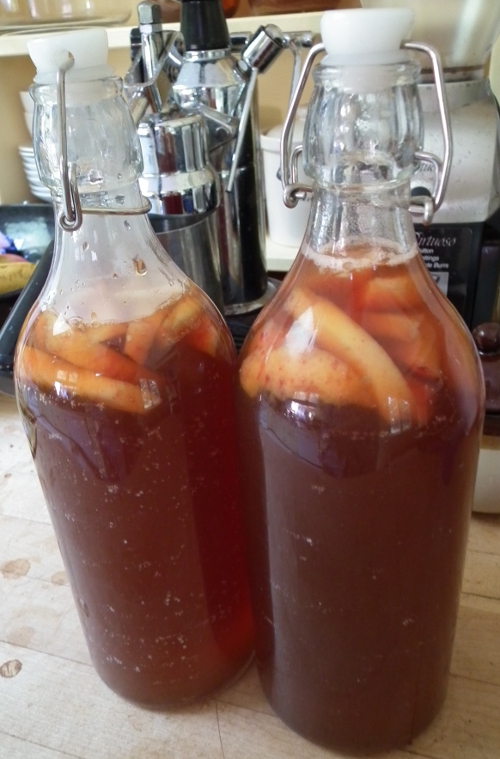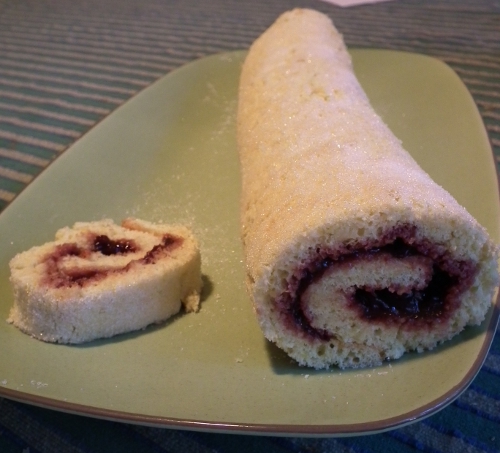
August is all about food. All the colors are coming in now: deep green collards and brussels sprout leaves, yellow squashes, red tomatoes, orange peaches, purple eggplants, and blueberries are holding in there. The bees are turning the orange and yellow nectar (over)flow into oodles of honey. At the end of the month there will also be crisp apples. Â Then the mushrooms will start rising up…
I am making food with the help of living organisms. A thick, moist sprouted whole wheat bread with lots of egg in it.  Kombucha tea with peaches going into secondary fermentation for carbonation and flavoring. Pickled cucumbers with the kombucha vinegar (pasteurized by the canning process). I want to try my hand at kimchi too, and will make sauerkraut as soon as my CSA box brings a fat cabbage head. In the meantime, I’m also experimenting with a biscuit roll. I follow my friend’s recipe but with jam instead of cream filling and it comes out just like my grandmother used to make it. It means a lot to me that the five eggs are “homegrown” and the jam homemade, from local plums, in this case.
Amie and I got books on goats at the library and getting goats seems like a whole new challenge. Goats were on our mind so much yesterday that when we read, in a beautiful book on flowers, the following quote:
– A flower is a leaf gone mad with love –
we attributed it to “Goatee,” then laughed and read the name right:Â Goethe.
Handling food, living or just plucked or dug, I think of how they’re all of them – roots, leaves, flowers, fruits - about always more life and sex (“love” in Goethe’s romantically correct jargon). This in turn proved the perfect mindset for me to read, in Rebecca Solnit’s The Faraway Nearby, the chapter “Ice.” It is about starvation and death and whiteness at the North Pole. The kernel is the story of Atagutaluk, who was trapped, with her family, in the frozen wastes. They ate the dogs, their clothes and shoes, then the children, the companions, the husband. She was found just in time, barely alive, a skeleton herself and “not human anymore,” she warned her rescuers. Solnit pairs the stories – for there are so many versions, each their own story, really – with fairy tales and myths of women  floating, steeping in the ocean, stripped to the bone.
What struck me was the contrast of this, my life of abundance, and Atagutaluk’s starvation. And how for the plants and animals in the world it is all about love/sex/more life, while for us the world is all about food. In some stories, Solnit points out, the heroine is restored (Atagutaluk’s story, and the folk tale the Skeleton Woman). But in others (the creation myth of Sedna), she remains at the bottom of the cold Arctic sea, afloat in a continual kind of dying, and the needs of the humans who tell the tale are addressed instead: out of her come the walruses and seals that feed them.
It is hard to tell where this leads, because it leads into so many directions. One is that I am thankful for the plants and animals that preserve my life. That, knowing who grew them, and where, and how, makes my thanks more concrete and thus more sincere. That perhaps my thanks returns something, puts some flesh back on those bones. That, at a minimum, the one who feeds me, regardless of whether I deserve it or not, is not forgotten at my table.

Nice! Looks lovely, glad it was what you remembered from childhood. Go visit Land’s Sake in Weston for a look at those baby goats. I’m so in love with them.